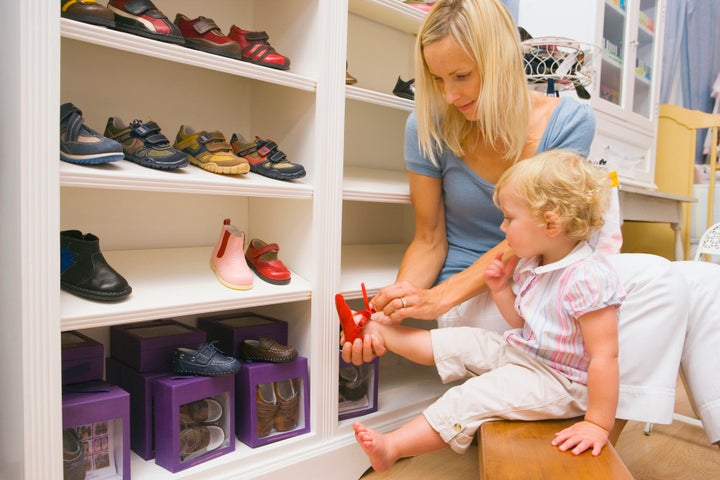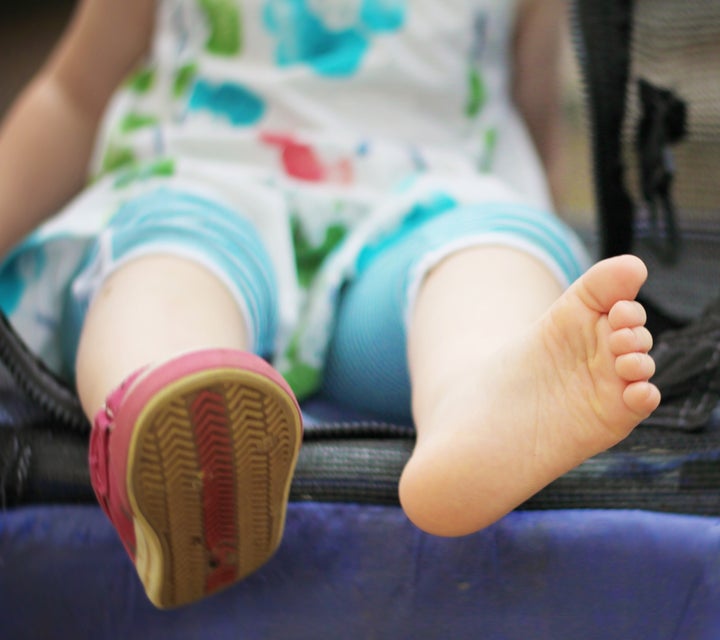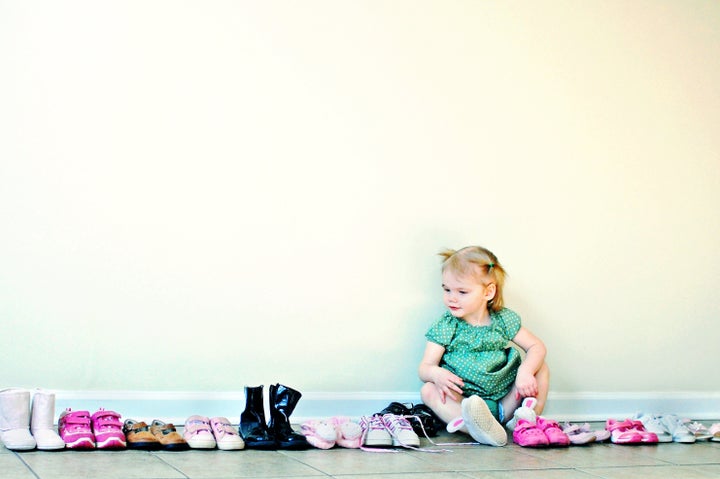Here’s our guide to everything you need to know when you’re buying your child’s first shoes, from when and where to have shoes fitted to how to keep their tiny toes in tip top health.

When should I buy my child’s first shoes?
It’s tempting to hotfoot it to the nearest shoe shop the minute your little one starts cruising, but according to The Society of Chiropodists and Podiatrists, they don’t actually need proper shoes until they’ve been walking confidently for several weeks.
Until then, bare feet are best – this allows their tiny toes to wiggle, their feet to develop properly, and encourages them to walk as they’re less likely to slip.
My child’s not walking properly yet, but his feet need protecting. What should I do?
If your child’s cruising on wooden or tiled floors, bare feet can be cold, and socks can turn the floor into a skating rink.
“In this case, choose a specially-designed pre-walking shoe,” says Bob Hardy, fitting manager for Clarks.
“These should be lightweight with thin bendy soles and breathable linings and uppers, and come in half sizes and width fittings to help walking development. Just like the proper, more supportive, thicker-soled shoes they’ll wear when they’re actually toddling, pre-walkers should be fitted by an expert.”
How about slippers?
Slippers look cute, but the sensible (OK, boring) official advice is that they’re not designed to be worn for hours on end.
“Avoid slippers except for first thing in the morning and after bath time,” says Bob. “They rarely come in half sizes and width fittings or have effective fastenings. Babies can feel insecure in slippers and curl their toes for a better grip – they might even stop wanting to learn new walking skills.”
What happens at a first fitting?
Gone are the scary fitting machines that used to ‘swallow up’ children’s feet. Instead, the assistant will use a handheld mini foot gauge that measures both length and width.
Most children have one foot bigger than the other, so they should fit to the largest one – a properly-fitting shoe should be 12-16mm longer than your baby’s big toe. Then comes the fun part – trying things on.
Don’t worry if the assistant selects a different size from the one on the gauge – just as you might be a dress size 12 in TopShop and a 14 in M&S, baby shoe sizes vary between brands and styles.

What style should I go for?
The good news is you can choose anything from boots to sandals – as long as the shoes fit properly.
If your toddler’s a wriggler, Velcro is the easiest to do up; but if they love pulling socks and shoes off, then buckles or laces may be better to outwit them.
If you go for laces, check they’re long enough to tie a double knot so that you don’t get a backache bending down to retie them every five minutes.
Are some materials better for children’s shoes than others?
Your child may not hit puberty - and develop all those extra stinky sweat glands - for many years yet, but their feet can still perspire. A lot.
“Synthetic materials and plastic coatings prevent tiny feet from breathing and the shoes drying out,” says Bob.
“Your best bet is leather as it lets the skin breathe, and canvas or cloth, which lets air circulate.”
As for the sole, go for something flexible, preferably with a raised tread for extra grip.
How can I tell if the shoes are uncomfortable?
Toddlers’ feet are ultra flexible and their nerve endings are still forming, so they can squeeze into badly-fitting shoes without complaining. So, how do you know when something’s wrong?
“Let your child walk around indoors for a bit – when you take the shoes off, there shouldn’t be any significant red marks or pressure lines,” explains Bob.
“Other signs include your child constantly trying to pull their shoes off, or walking differently – although that could just be a new developmental stage.”
Another tip is to go shoe shopping in the afternoon rather than in the morning, as toddlers’ feet can swell during the course of the day.

How tight should I do up my toddler’s shoes?
You might remember your parents tying your laces so tight you thought your feet would drop off, but they knew what they were doing. Sort of.
“Shoes do need to be firmly fastened so that they don’t slide around or come off,” says Bob.
“Always check the fastening is firm when your child is standing, as the foot shape changes when it’s flat. Then, sit them down and pull gently but firmly on the back of the shoes - there should be little or no movement between the shoe and the foot.”
How often should I get my toddler’s feet remeasured?
Toddlers’ feet grow fast - up to two sizes a year until they’re around four years old. So, check the fit (or get your little one re-measured in a shop) every six to eight weeks.
If a shoe still fits, there should be around a thumb’s width between the front of the shoe and your child’s big toe. If their toes are hitting the front, it’s time for a new pair.
But these tiny shoes are so expensive! Is it OK to buy them secondhand?
With properly-fitted leather toddler shoes costing £30 upwards in the shops, but as little as £2.50 on eBay, it’s tempting to only ever set foot inside a shoe shop for a fitting. Besides, with little feet growing so fast, how much wear and tear can the previous owner really have done to a pair in just a couple of months?
“Despite what you’d think, it only takes a few weeks for shoes to mould to the wearer’s foot shape and walking style,” says Bob.
“Even if the secondhand pair is the correct size, there’s a chance they could affect your baby’s walking development, so they’re best avoided if you can.”
Darn. Better start that new shoe fund now!
Useful websites:
The Children’s Foot Health Register lists local shoe shops with staff trained in children’s fitting